From a box of matches to 411 stores: the history of the new IKEA museum
In this blog, we are mainly talking about startup programs, development, prospects, and in general about what lies ahead. What about "accelerator to the past"? A year and a half ago, in the Swedish city of Elmhulte, where the history of IKEA began, instead of the exhibition IKEA Through the Ages, a new large company museum opened. We invite you to a tour under the cat.

The IKEA museum is located in the same building where in 1958 the first full-fledged store of the company was opened. Since then, the building has hardly changed.

')
At the entrance, we are met by the founder of IKEA Ingvar Kamprad. His portrait is made up of miniature photos of IKEA employees. This simultaneously denotes the importance of each employee and refers us to the main goal of the company - (literally) “to create a better everyday life for many people.”


The path to the main exhibition is through a bright corridor with IKEA branded products. Today, an assortment of about 10 thousand products, about a quarter of which change annually.
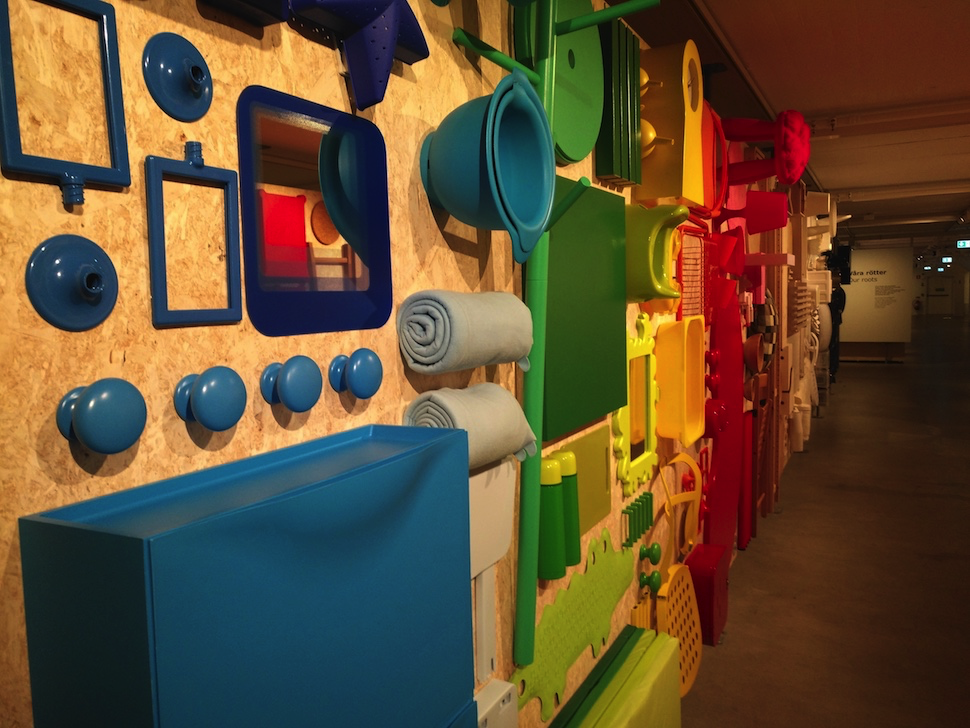
To appreciate the scale of diversity, it’s enough to go back 1.5 hundred years ago, when everything was not so fun. The tour begins with a typical Swedish dwelling of the time:

The Swedes lived mostly large families in small rural houses. In the photo above - the kitchen. Often she was the only room in the house and was used as a living room, nursery, bedroom, etc. In such conditions, functionality came out on top. Tablecloths turned into bedspreads. Tables were folding. The beds had drawers for things. People tried to sleep together to keep warm. Children's cradles hung from the ceiling, so that the babies were next to the mother and at the same time were far from the fire of open fires, and later - from kerosene lamps. Iron products, which could facilitate life, were not widely distributed due to the high cost.
Severe Swedish climate made it difficult for agriculture, which was limited mainly to cattle breeding. The forest resources helped somehow, but life was still very difficult. From the end of the 19th century, within about 30–40 years, about a third of the population of Sweden left the country. They left mainly to America.
At this time, ideas of a simple and high-quality situation in a house decorated in bright colors were spread in Sweden. They were developed by the Swedish writer Ellen Kay, as well as the Karin and Karl Larsson family. Karl was an artist, and Karin was an interior designer. They embodied their ideas in small paintings that became very popular in Sweden. In these pictures are depicted the houses of the future - those in which the Swedes would like to live. In the future, the Larsson projects have influenced the entire work of IKEA.
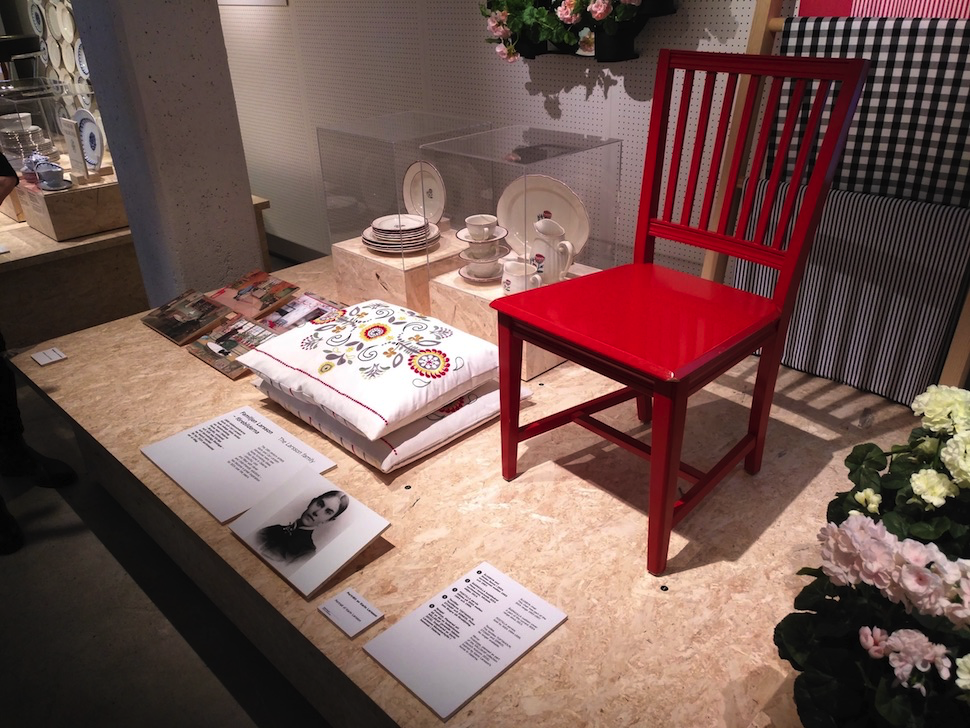
Swedish writer Ellen Kay and home furnishings that matched her ideas
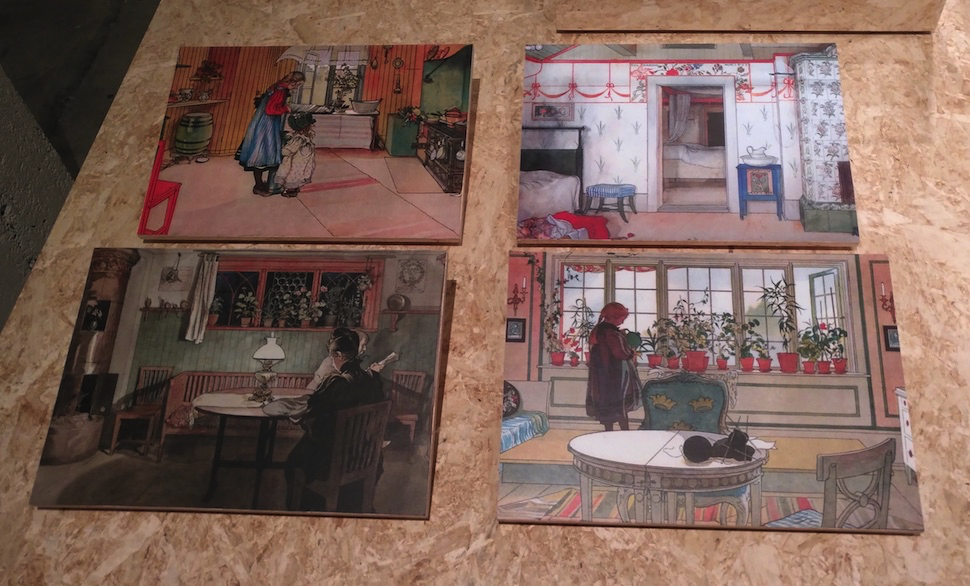
Works of the Larsson family, common in Sweden
Dreams of a better life led people from villages to cities. The most significant resettlement occurred in the 1930s. But in the cities everything was even worse: diseases spread and people continued to leave the country. The Swedish government has embarked on a standardization and improvement of urban housing. This was the main theme of the 1930 Stockholm exhibition, where young architects and designers presented a variety of solutions for lighting, efficient use of space, and mass production. The new trend was called "functionalism".
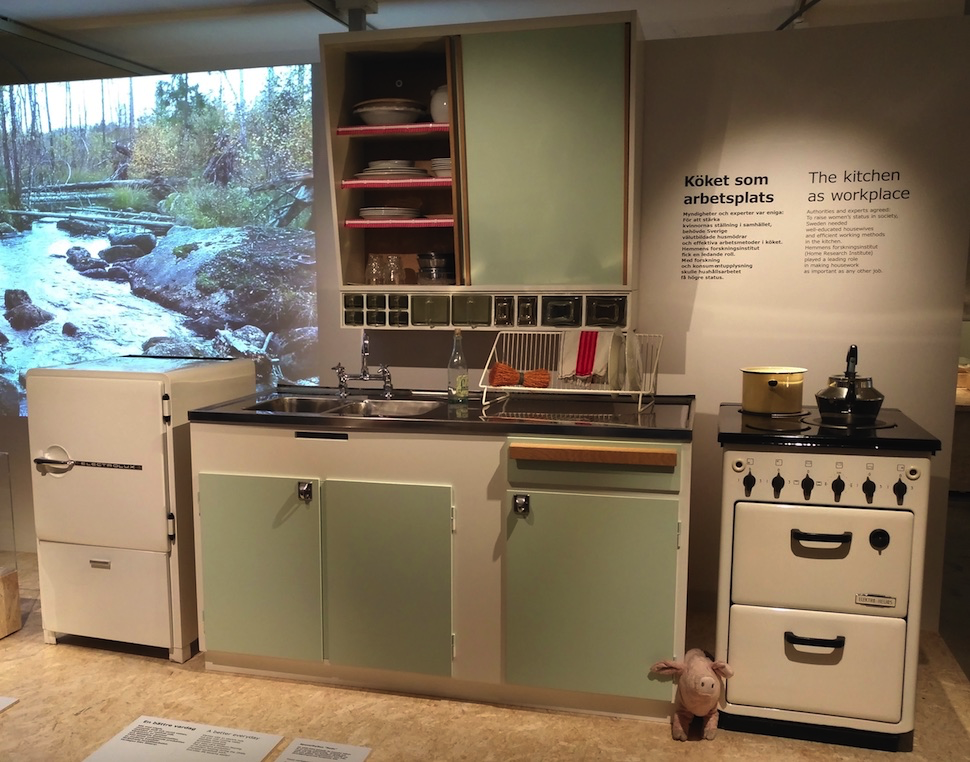
An example of functional Swedish cuisine of the time. Gas, electricity, everything is done to save time. At that time, it was believed that both men and women should work in the family: this allowed them to collect more taxes and, accordingly, quickly improve the lives of citizens. As a result, even free dental care appeared.
At that time, Ingvar Kamprad, the future founder of IKEA, began his first business in Agunnarude. Things on the farm of his grandparents were going badly, the family was in need. To help the family, six-year-old Ingvar bought large blocks of matches in one of the shops in Stockholm and then sold them by box. Ability to business developed rapidly, the boy actively explored the neighborhood in terms of supply and demand. Ingvar began selling seeds, pens, fish, Christmas cards ... well, a lot of useful things.

One of the first logos of IKEA
In the summer of 1943, Ingvar received permission to establish his own company. IKEA is an abbreviation: IK - Ingvar Kamprad, E - Elmtaryd (the farm that Ingvar grew up on), A - Agunnaryd (Ingvar's hometown). Fortunately, the name invented by the founder is easily pronounced in all corners of the world, so over time it was not necessary to change it.
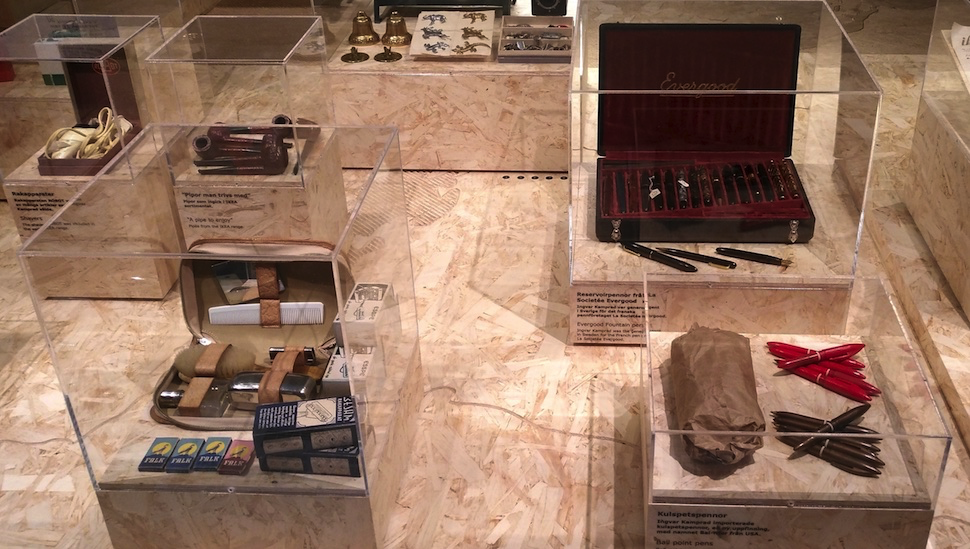
One of the first IKEA products
At first, IKEA sold everyday goods from ballpoint pens and watches to tubes and hairbrushes. All this could be bought from his home or ordered with delivery: Ingvar himself transported goods on a bicycle. But the competition in this segment was very high.
In 1948, a local furniture designer knocked on the door of Ingvar's house. “Don't you want to sell furniture in IKEA?” He asked. “Yes, but I don’t know how to do it,” answered Ingvar and called his mother for advice. Mom solved the problem quickly, pointing to two chairs and a coffee table in the room. So the first furniture appeared in the company's assortment. But to stand out among competitors, the usual sale was not enough.
In 1953, IKEA acquired an old store in Elmhult and made it a showroom where people could look at the furniture before ordering. An unusual step was a success: they started talking about the company all over the country, and customers began to come from afar. Two years later, to counteract the collusion of suppliers, IKEA begins to develop furniture with its own design.
As a result, in 1958, here, in Elmhult, not far from the showroom, the first IKEA was opened - the largest furniture store in Northern Europe. The store is quickly gaining popularity: buyers come from all over Sweden and from other countries, queues are lining up.

The store workers knew the assortment perfectly well and had an idea of the principles of home design. IKEA actively recruited employees among housewives who understood home problems and needs the best. These employees were considered experts and were very valuable in the stores: customers could pre-order with them personalized tours of IKEA. During the tours, experts gave advice on home furnishings, noted products to which buyers showed interest. Small purchases could immediately take home, orders for the overall furniture sent to suppliers.
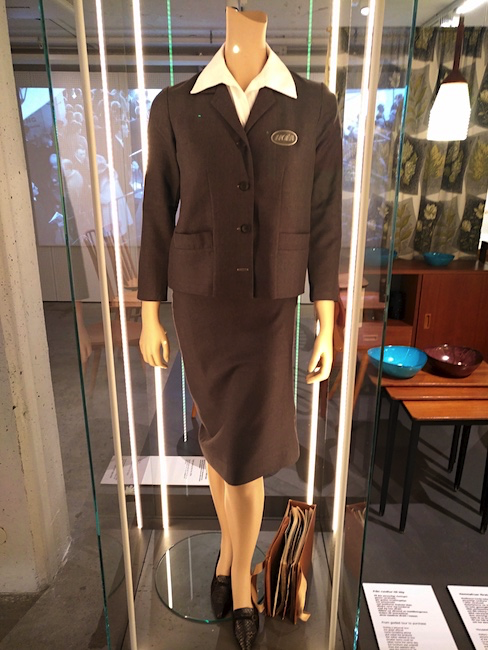 The uniforms of the IKEA employee of the 50s and her folder with catalogs
The uniforms of the IKEA employee of the 50s and her folder with catalogs
In the catalog of that time there was a questionnaire of 20 questions, as well as the insertion of "graph paper" on which buyers could roughly arrange the furniture. With all this information, IKEA staff made individual offers.

One of the first products in the range of IKEA. The green chair in the background in a slightly modified form is still on sale.
In the 60s comes a new round of competitive war. Raw materials suppliers in Sweden have been presented with an ultimatum: “If you want to work with us, you will have to end relations with IKEA.” Many have done so. But this time the company found a way out.
At that time, furniture was made mainly from dark woods - teak and walnut. Having researched the external market, IKEA found a large amount of wood suitable for furniture in Poland. It was a light oak. Buyers liked the new color, and since then this breed is actively used in production. By the way, Poland is among the five largest furniture-producing countries of IKEA together with China, Sweden, Lithuania and India.
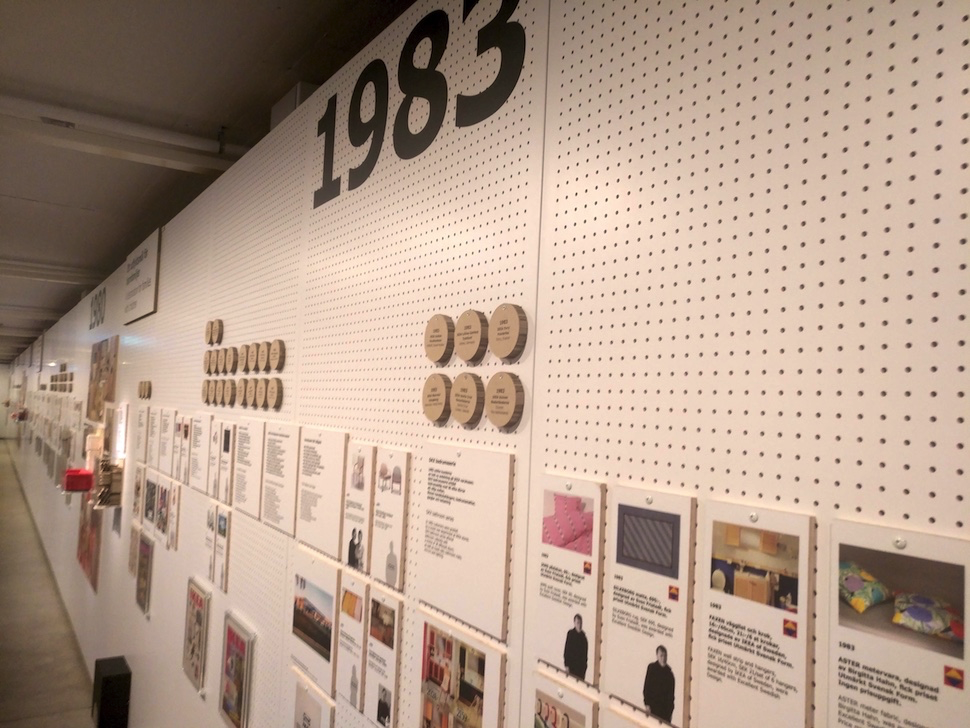
The hall of the museum is surrounded by a “chronological wall”. The rectangles show the important stages in the story, and the circles show the open stores. The largest is now in Seoul, and the most extensive in terms of range is still here in Elmhult.
The tour is logical to complete something very important for IKEA. We are approaching the five principles of “democratic design”, which the company's products must meet - Form, Function, Quality, Low Price, Sustainability. This concept is so important that a separate wall is set aside for it in the museum.
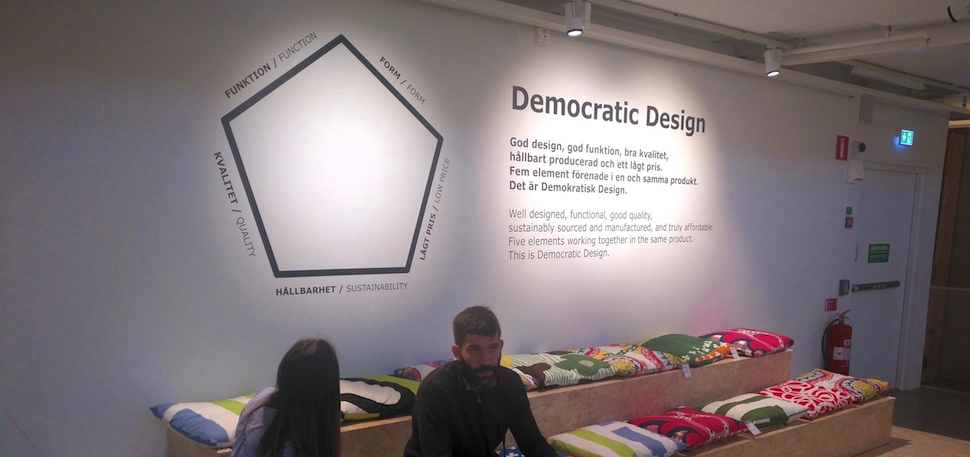 These principles are supported by a set of rules called IWAY, consisting of 80 items on labor, social conditions, environmental protection and other things. A book with these rules is in every IKEA store.
These principles are supported by a set of rules called IWAY, consisting of 80 items on labor, social conditions, environmental protection and other things. A book with these rules is in every IKEA store.
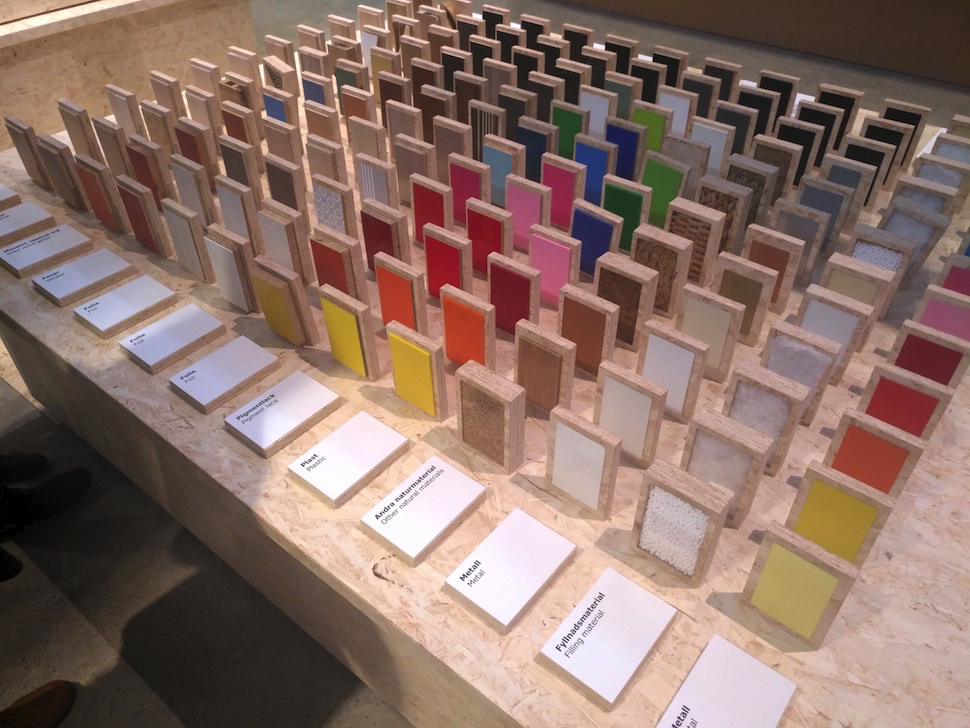
All colors used in IKEA products, with reference to materials. The same palette is separately for them.
What can you do in the museum, besides studying the history of IKEA? For example, to let the plastic balls from the upper floor to the lower one through the pneumolabirin. Around this maze swirl posters with goods from the current range of the store. You can take pictures in the interior with the current cover of the IKEA catalog and get your own funny option.
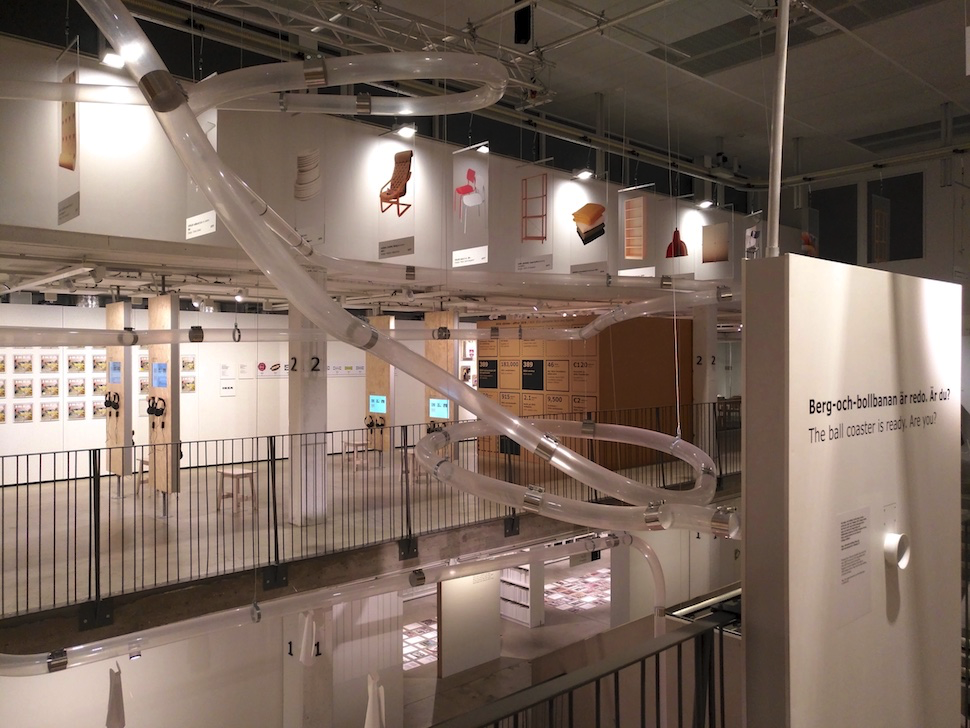
But the most interesting is the store on the ground floor. It seems that IKEA’s usual products are collected here - but the peculiarity is that they are sold only in the museum: exceptionally small chairs, original dishes, designer figurines, posters and other things.
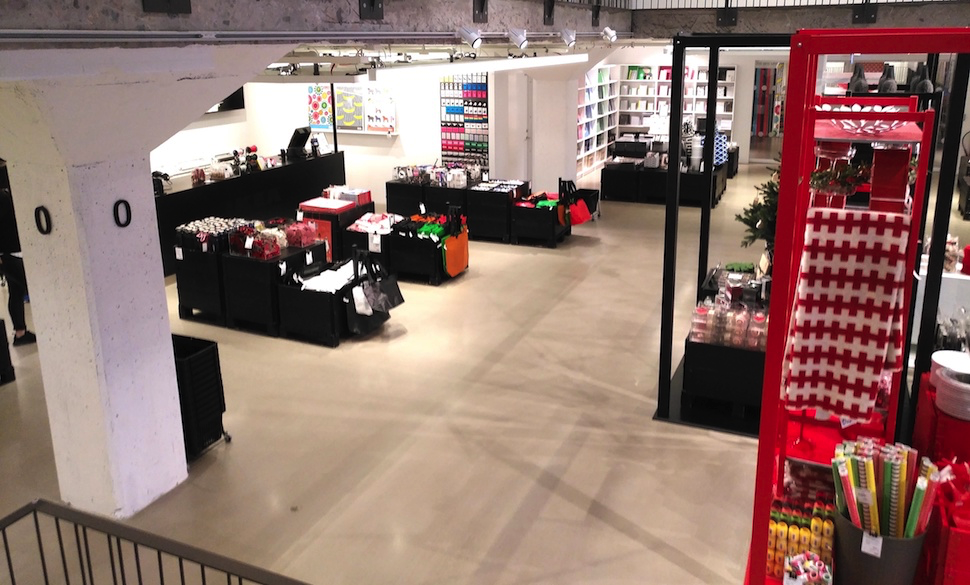
IKEA continues to develop the museum and for this purpose leaves several copies of each new product for the future. So over time, everything will be even more interesting.

The IKEA museum is located in the same building where in 1958 the first full-fledged store of the company was opened. Since then, the building has hardly changed.

')
At the entrance, we are met by the founder of IKEA Ingvar Kamprad. His portrait is made up of miniature photos of IKEA employees. This simultaneously denotes the importance of each employee and refers us to the main goal of the company - (literally) “to create a better everyday life for many people.”


The path to the main exhibition is through a bright corridor with IKEA branded products. Today, an assortment of about 10 thousand products, about a quarter of which change annually.

To appreciate the scale of diversity, it’s enough to go back 1.5 hundred years ago, when everything was not so fun. The tour begins with a typical Swedish dwelling of the time:

The Swedes lived mostly large families in small rural houses. In the photo above - the kitchen. Often she was the only room in the house and was used as a living room, nursery, bedroom, etc. In such conditions, functionality came out on top. Tablecloths turned into bedspreads. Tables were folding. The beds had drawers for things. People tried to sleep together to keep warm. Children's cradles hung from the ceiling, so that the babies were next to the mother and at the same time were far from the fire of open fires, and later - from kerosene lamps. Iron products, which could facilitate life, were not widely distributed due to the high cost.
Severe Swedish climate made it difficult for agriculture, which was limited mainly to cattle breeding. The forest resources helped somehow, but life was still very difficult. From the end of the 19th century, within about 30–40 years, about a third of the population of Sweden left the country. They left mainly to America.
At this time, ideas of a simple and high-quality situation in a house decorated in bright colors were spread in Sweden. They were developed by the Swedish writer Ellen Kay, as well as the Karin and Karl Larsson family. Karl was an artist, and Karin was an interior designer. They embodied their ideas in small paintings that became very popular in Sweden. In these pictures are depicted the houses of the future - those in which the Swedes would like to live. In the future, the Larsson projects have influenced the entire work of IKEA.

Swedish writer Ellen Kay and home furnishings that matched her ideas

Works of the Larsson family, common in Sweden
Dreams of a better life led people from villages to cities. The most significant resettlement occurred in the 1930s. But in the cities everything was even worse: diseases spread and people continued to leave the country. The Swedish government has embarked on a standardization and improvement of urban housing. This was the main theme of the 1930 Stockholm exhibition, where young architects and designers presented a variety of solutions for lighting, efficient use of space, and mass production. The new trend was called "functionalism".

An example of functional Swedish cuisine of the time. Gas, electricity, everything is done to save time. At that time, it was believed that both men and women should work in the family: this allowed them to collect more taxes and, accordingly, quickly improve the lives of citizens. As a result, even free dental care appeared.
At that time, Ingvar Kamprad, the future founder of IKEA, began his first business in Agunnarude. Things on the farm of his grandparents were going badly, the family was in need. To help the family, six-year-old Ingvar bought large blocks of matches in one of the shops in Stockholm and then sold them by box. Ability to business developed rapidly, the boy actively explored the neighborhood in terms of supply and demand. Ingvar began selling seeds, pens, fish, Christmas cards ... well, a lot of useful things.

One of the first logos of IKEA
In the summer of 1943, Ingvar received permission to establish his own company. IKEA is an abbreviation: IK - Ingvar Kamprad, E - Elmtaryd (the farm that Ingvar grew up on), A - Agunnaryd (Ingvar's hometown). Fortunately, the name invented by the founder is easily pronounced in all corners of the world, so over time it was not necessary to change it.

One of the first IKEA products
At first, IKEA sold everyday goods from ballpoint pens and watches to tubes and hairbrushes. All this could be bought from his home or ordered with delivery: Ingvar himself transported goods on a bicycle. But the competition in this segment was very high.
In 1948, a local furniture designer knocked on the door of Ingvar's house. “Don't you want to sell furniture in IKEA?” He asked. “Yes, but I don’t know how to do it,” answered Ingvar and called his mother for advice. Mom solved the problem quickly, pointing to two chairs and a coffee table in the room. So the first furniture appeared in the company's assortment. But to stand out among competitors, the usual sale was not enough.
In 1953, IKEA acquired an old store in Elmhult and made it a showroom where people could look at the furniture before ordering. An unusual step was a success: they started talking about the company all over the country, and customers began to come from afar. Two years later, to counteract the collusion of suppliers, IKEA begins to develop furniture with its own design.
As a result, in 1958, here, in Elmhult, not far from the showroom, the first IKEA was opened - the largest furniture store in Northern Europe. The store is quickly gaining popularity: buyers come from all over Sweden and from other countries, queues are lining up.

The store workers knew the assortment perfectly well and had an idea of the principles of home design. IKEA actively recruited employees among housewives who understood home problems and needs the best. These employees were considered experts and were very valuable in the stores: customers could pre-order with them personalized tours of IKEA. During the tours, experts gave advice on home furnishings, noted products to which buyers showed interest. Small purchases could immediately take home, orders for the overall furniture sent to suppliers.

In the catalog of that time there was a questionnaire of 20 questions, as well as the insertion of "graph paper" on which buyers could roughly arrange the furniture. With all this information, IKEA staff made individual offers.

One of the first products in the range of IKEA. The green chair in the background in a slightly modified form is still on sale.
In the 60s comes a new round of competitive war. Raw materials suppliers in Sweden have been presented with an ultimatum: “If you want to work with us, you will have to end relations with IKEA.” Many have done so. But this time the company found a way out.
At that time, furniture was made mainly from dark woods - teak and walnut. Having researched the external market, IKEA found a large amount of wood suitable for furniture in Poland. It was a light oak. Buyers liked the new color, and since then this breed is actively used in production. By the way, Poland is among the five largest furniture-producing countries of IKEA together with China, Sweden, Lithuania and India.

The hall of the museum is surrounded by a “chronological wall”. The rectangles show the important stages in the story, and the circles show the open stores. The largest is now in Seoul, and the most extensive in terms of range is still here in Elmhult.
The tour is logical to complete something very important for IKEA. We are approaching the five principles of “democratic design”, which the company's products must meet - Form, Function, Quality, Low Price, Sustainability. This concept is so important that a separate wall is set aside for it in the museum.
 These principles are supported by a set of rules called IWAY, consisting of 80 items on labor, social conditions, environmental protection and other things. A book with these rules is in every IKEA store.
These principles are supported by a set of rules called IWAY, consisting of 80 items on labor, social conditions, environmental protection and other things. A book with these rules is in every IKEA store.
All colors used in IKEA products, with reference to materials. The same palette is separately for them.
What can you do in the museum, besides studying the history of IKEA? For example, to let the plastic balls from the upper floor to the lower one through the pneumolabirin. Around this maze swirl posters with goods from the current range of the store. You can take pictures in the interior with the current cover of the IKEA catalog and get your own funny option.

But the most interesting is the store on the ground floor. It seems that IKEA’s usual products are collected here - but the peculiarity is that they are sold only in the museum: exceptionally small chairs, original dishes, designer figurines, posters and other things.

IKEA continues to develop the museum and for this purpose leaves several copies of each new product for the future. So over time, everything will be even more interesting.
Source: https://habr.com/ru/post/350064/
All Articles